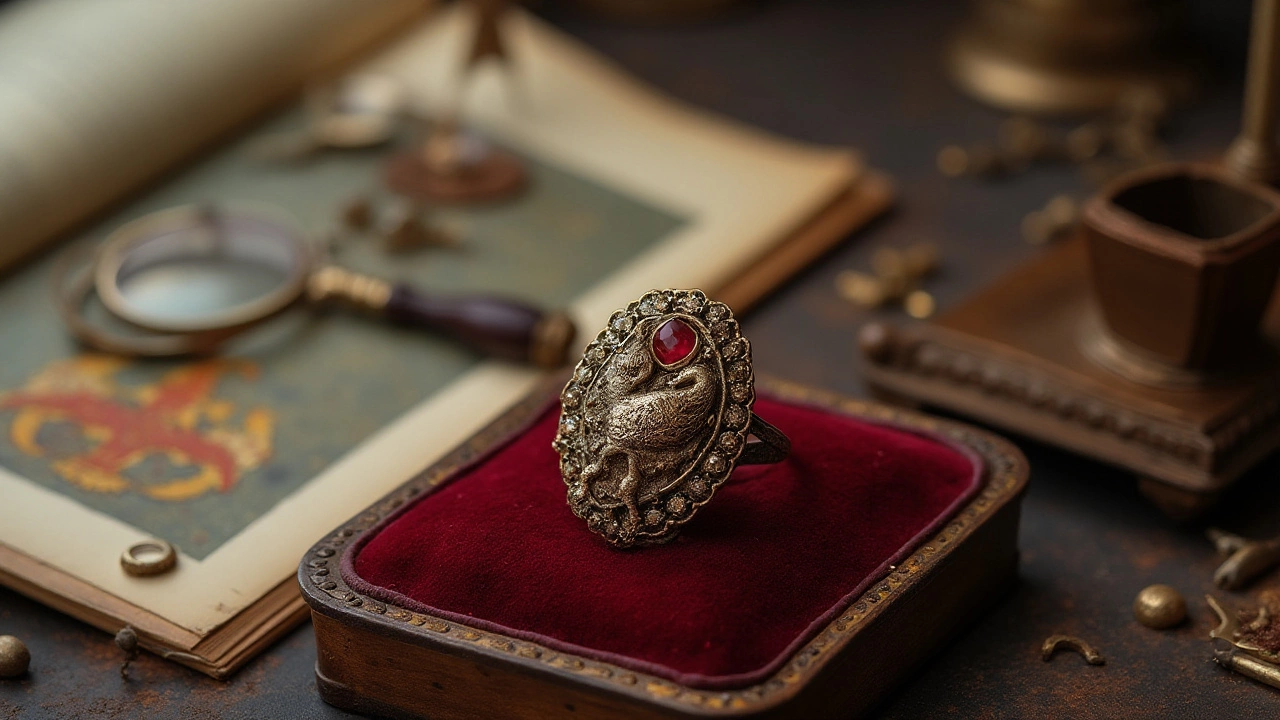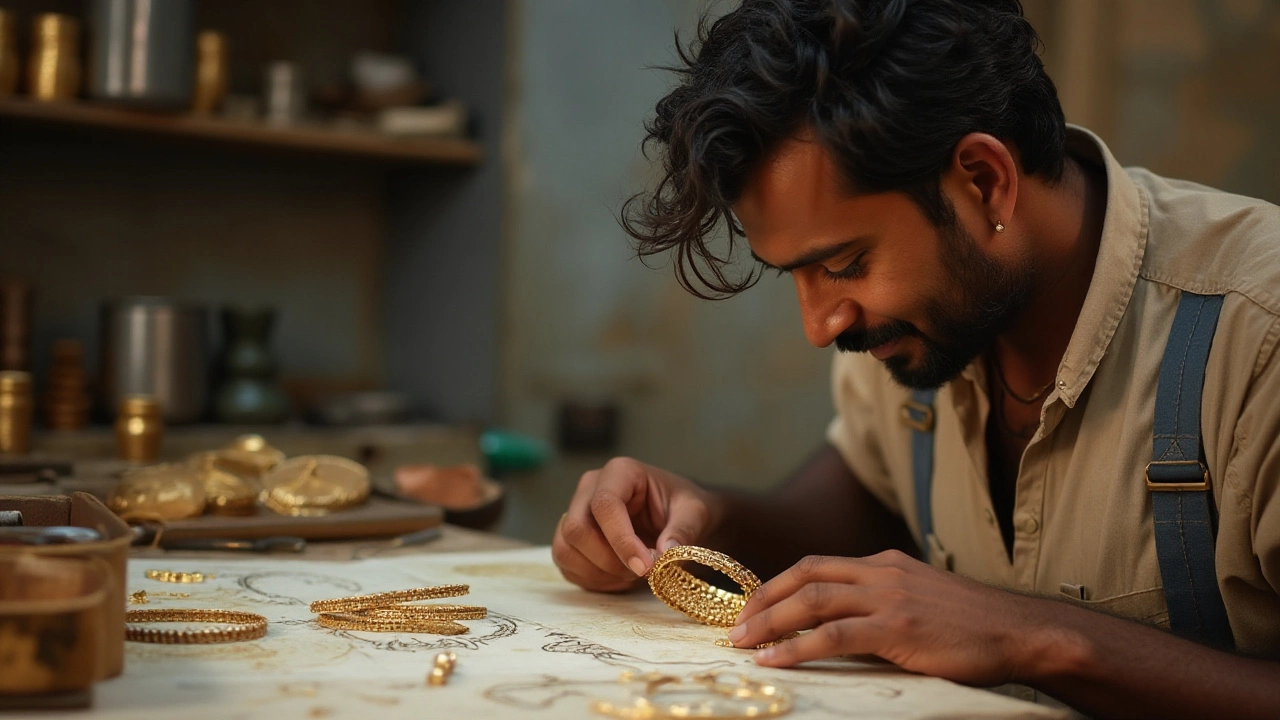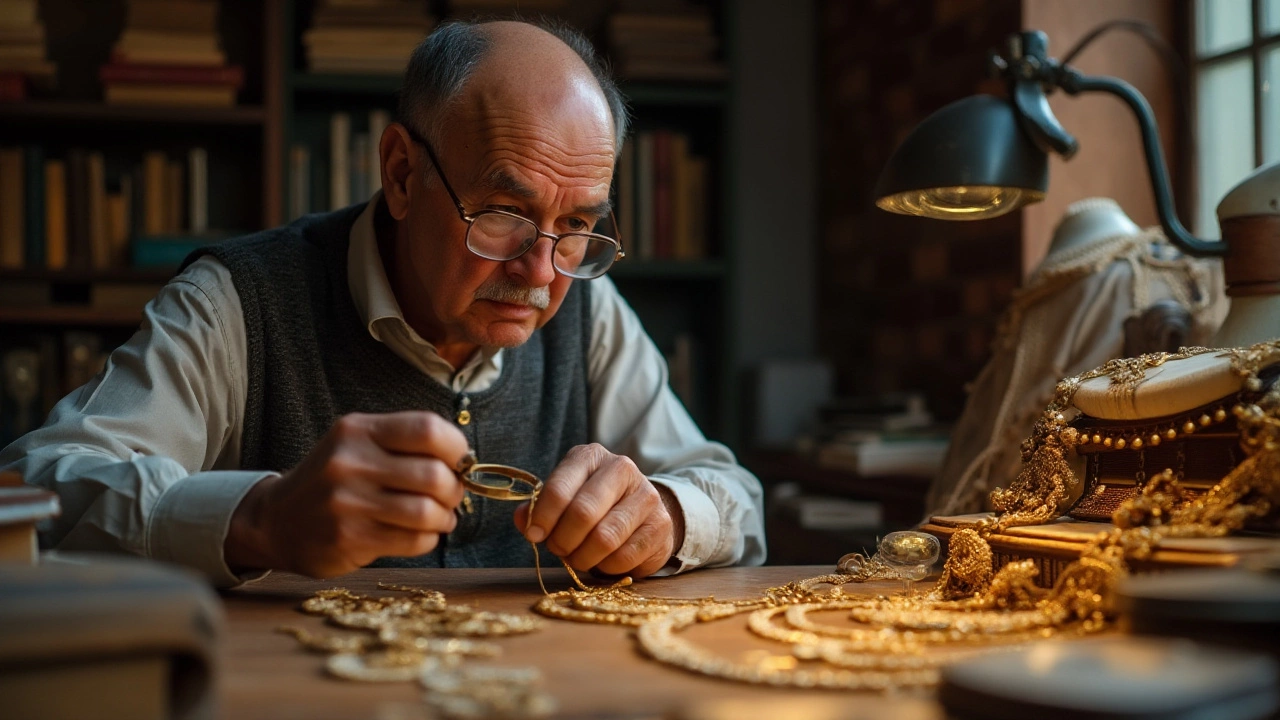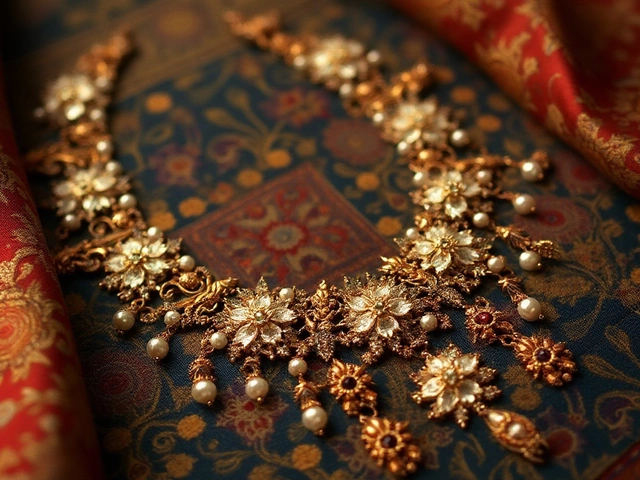When you lay your eyes on a piece of antique jewelry, the sparkle doesn't only lie in the gem but also in the history it carries within its curves and glint. Each antique piece whispers stories of its past, the Victorian grandeur or the art nouveau charm, yet, the challenge is deciphering whether these whispers are genuine or merely stories crafted to deceive.
The path to authentication doesn't require a genie. It demands attention to details and a keen eye for the elements that signify age and rarity. Join me as we embark on an enlightening journey into the realm of antique jewelry, unlocking the secrets that tell tales of authenticity, uniqueness, and artistic heritage.
- Understanding Hallmarks
- Material Examination
- Craftsmanship and Design
- Historical Context
- Engaging with Experts
- Signs of Reproduction
Understanding Hallmarks
The allure of antique jewelry often begins with the mystery of its origin, but the key to uncovering this mystery lies entrenched in the hallmark. These tiny stamped symbols or numbers on a piece of jewelry are like fingerprints, unique to their time and maker. They reveal volumes about a piece’s history, its cultural journey, and most importantly, its authenticity. Understanding these marks is essential for anyone serious about collecting or selling real vintage treasures.
First and foremost, hallmarks can indicate the type of metal used. For example, a piece with a '925' stamp suggests that it's sterling silver, holding significance as one of the most revered silver alloys for its durability and lustrous beauty. Gold, on the other hand, might be marked with '750', which indicates 18 karat purity. Knowledge of these numbers can help you decipher whether a piece fits the bill of authenticity when it claims to be antique.
In many countries, hallmarking traditions date back centuries and serve as a method to safeguard against fraud. This can include both purity marks and maker's marks, which are small symbols identifying the artisan or company responsible for the piece. Britain's hallmarking system is especially renowned, with records dating back to 1300. A British hallmark might include the Leopard’s Head for London or the Anchor for Birmingham, each adding a layer of intrigue to the jewelry's story.
"Hallmarks are the jewel's heart, whispering tales of the past," explains jewel historian Annette Sherefeld, an expert in the field of vintage adornments. Her sentiment highlights the importance of these marks.
The era of a piece can often be deduced from its hallmark as well. Art deco pieces from the early 20th century can be identified by certain stylistic motifs in their marks. This contrasts sharply with Victorian pieces, which might bear more ornate and elaborate hallmarks, reflecting the intricate craftsmanship favored in that period. Knowing which symbols associated with which timelines helps in placing the piece in its rightful historical context.
However, not all hallmarks tell an easy tale. Some may have worn away over the years, especially on well-loved pieces. When such cases arise, it becomes imperative to consult jewelry identification guides or expert appraisers who can provide insight into faded hallmarks. Their experience and understanding of minute differences in marks can often resurrect the lost narrative of a piece.
Mastering the art of reading hallmarks not only aids in identifying the authenticity of an antique jewelry piece but also enriches your appreciation of the artistry and heritage embedded in each piece. Armed with this knowledge, one can journey through time with each piece, uncovering layers of history one mark at a time.
Material Examination
Unveiling the secrets hidden within the materials of antique jewelry is akin to being a detective in pursuit of truth. The essence of a jewel's authenticity often resides in the metals and stones it's crafted from, and understanding these materials becomes crucial. The metals, for instance, have evolved significantly over the centuries. Pure gold, often alloyed with silver or copper, was a favorite in older jewelry. Platinum, known for its durability, didn't become widely used until the late 19th century, which provides a timeline clue for pieces claiming earlier provenance.
Differentiating authentic pieces from clever imitations requires discernment. An unmarked gold piece, often seen in contemporary reproductions, would be rare in genuine antiquities, as hallmarking evolved alongside hallmark laws. It's insightful to remember that hallmarked pieces started appearing more as branding and consumer protection measures. Stones offer another rich area for exploration. Real vintage gems, like beautiful old mine-cut diamonds or natural pearls, showcase imperfections absent in their modern, synthetic counterparts. A real diamond, for instance, has tiny inclusions visible under a loupe, echoing their natural origin, unlike a lab-created gem.
To better appreciate the materials used, consider the importance of silver. Sterling silver, which is 92.5% pure silver, was commonly used in antique jewelry. The tarnish that accumulates on these pieces over time can be an indicator of age, as well as careful usage. Silver pieces from earlier eras might lack uniformity as today's manufactured ones, offering a natural patina that many collectors find alluring. In contrast, chromed or silver-plated base metals signal reproductions aiming to mimic genuine sterling articles without the intrinsic value.
Materials seen within antique jewelry also shed light on the historical context. For instance, the trend towards using enamels during the Art Deco period tells stories extending beyond mere decoration to expressions of the era’s artistic sensibilities. When examining enamel work on jewel pieces, look for signs of handcrafting. Perfectly smooth and bubble-free enamel might actually indicate a 20th-century machine-driven process, quite unlike earlier hand-applied methods which bore a personal touch.
If in doubt, seeking expert opinions can also significantly enhance your understanding. As quoted by renowned jeweler, James Wainright, "True antique jewelry bears the essence of its maker's personality etched within the material itself." This essence is what turns a mere ornament into a narrative worth uncovering, enhancing the allure for historians and enthusiasts alike.
In navigating the path to understanding materials, educational resources become allies. Workshops and courses led by gemologists can equip you with the skills to identify stones and metals accurately. Subscribing to journals focused on gems and antiquities can also provide current insights and trends, keeping your knowledge up-to-date. The more you know about the materials, the better armed you are to spot authentic real vintage pieces that just might include that breathtaking find.

Craftsmanship and Design
The allure of antique jewelry is often lodged deep within the careful craftsmanship and intricate design that define its era. Each period in history brought forth distinctive styles, setting the stage for artisans to etch their creativity into pieces that are still treasured today. The craftsmanship of genuine antiques often reflects the technological limitations and artistic brilliance of their time, which replicators struggle to imitate. Artisans in the Victorian era, for instance, honed their skills in creating intricate settings using fine metalwork and colorful gemstones meticulously placed to capture the light in an almost magical manner.
Close attention should be paid to the details in the settings and clasps, as these small elements can reveal significant insights into the piece's origin. Often, pieces made before the 19th century used clasps and settings different from those employed in the 20th century. If you scrutinize an authentic Victorian brooch, for instance, you might notice tiny, meticulous engravings that require an artisan's touch, a hallmark of that epoch. Comparatively, the machinery of today can't replicate that level of personal craftsmanship, though it may try to mimic the external aesthetics.
Moreover, the design elements can speak volumes, rooted deeply in the socio-cultural context of their time. Jewelry from the Edwardian era is known for its lace-like filigree and elegant bezel settings, a testament to an era that cherished sophistication and daintiness. In contrast, Art Deco design celebrated geometric patterns and bold hues, mirroring the dynamic changes of the roaring twenties. These thematic elements are not just design choices but historical commentaries embedded in metal.
An intriguing quality of these designs is how they preserve historical narratives, often invisible to the untrained eye. According to a jewelry expert quoted in Heritage Auctions, opulent Edwardian necklaces were often designed with simplicity to accessorize evening gowns understated by soft candlelight, where "less was truly more." Identifying these nuances aids collectors in discerning the authenticity of antique pieces.
"The artistry involved in crafting real vintage jewelry is a dialogue between the jeweler's imagination and the cultural zeitgeist," says Sarah Bunting, author of 'Eras of Elegance: A Journey through Jewelry History.' "Deciphering these conversations will lead you to the true spirit of an antique piece."
In exploring authentic antique jewelry, consider intertwining the knowledge of past motifs with the technical patterns engraved by historical artisans. Inspect cuts, consider color usage, and delve into materials, allowing these elements to unveil the stories they hold. Whether you are an ardent collector or a curious novice, nourishing your understanding of craftsmanship and design will enrich your journey through the mesmerizing world of real vintage adornments.
Historical Context
In the fascinating field of antique jewelry, understanding the historical context is akin to grasping the essence of art itself. Each era whispers distinct stories through the intricate designs and materials employed by the artisans of its time. As one delves into the past, it becomes apparent that styles serve as a window into the cultural, social, and economic weave of the epoch. The roaring opulence of the Victorian era, for instance, contrasted sharply with the geometric boldness of the Art Deco period. These jewels were more than mere ornaments; they depicted the era's sentiments and innovations, chronicling a timeline of human expression.
The Victorian era, lasting from 1837 to 1901, was marked by its elaborate designs, often featuring nature-inspired motifs, symbolizing an admiration for flora and fauna. Jewels from this time might showcase intricate gold filigree work or incorporate vibrant semi-precious stones within their elegant curves. Conversely, the Edwardian period leaned toward lighter, more delicate designs with the introduction of platinum as a popular metal, infusing a 'lace-like' appearance into jewelry, often accentuated with diamonds. Fast forward to the roaring 1920s, where Art Deco made its formidable entrance. Here, symmetry and geometric patterns took precedence, reflecting the thrilling advancements in architecture and technology, laid bare in the daring designs of the day.
Understanding these historical markers not only aids in identifying the real vintage pieces but offers a glimpse into the zeitgeist that shaped them. It's a realm where art and history intertwine, sparking a fascination that transcends mere aesthetics. It's worth noting the words of venerable jewelry historian, Diana Singer, who said, "Jewelry is one of the earliest forms of artistic expression of mankind, reflecting the ideas, advancements, and shifts of each period." This eternal dance through decades is what makes collecting antique jewelry a delightful pursuit, rich with stories untold.
Collectors often trace the authenticity and antique jewelry styling back to specific time frames by recognizing these design elements. Authentic jewelry, when appreciated within its historical context, becomes not only a possession but a cherished piece of art that narrates tales of yesteryears. If one finds a real vintage piece with clean, geometric lines and ornamental features, it likely hails from the 1930s. Dainty Edwardian designs, exhibiting intricate metallic craftsmanship, speak of elegance that contrasts starkly against the bolder expressions of periods that followed. In this amazing world of epochs gone by, each piece holds the promise of adventure and the thrill of discovery.

Engaging with Experts
When it comes to distinguishing an authentic piece of antique jewelry from a clever imitation, nothing quite rivals the seasoned eye of an expert. These specialists hold years of knowledge and experience, capable of uncovering the nuanced elements that often elude even the keenest amateur collectors. Their insights can unravel the stories hidden within a jewel, its era, and its craftsmanship. Many experts are well-versed in the subtleties of different time periods. For instance, they can differentiate between Art Deco pieces and Georgian-era jewelry simply through examination of style and technique.
Visiting reputable appraisers or consulting with seasoned dealers can offer peace of mind. They employ a variety of methods, such as utilizing high-magnification tools to inspect hallmarks or scrutinizing the settings to identify the period's signature craftsmanship. Their trained skills can often determine whether the metals have been treated or if stones retain their natural qualities, such as color and cut integrity. Such discernment is critical when an item’s authenticity could mean the difference of thousands in value. As Susan Friedel, a respected appraiser, states,
“An antique piece speaks its truth through the unspoken dialogue of detail and design—only those attuned to the subtleties of its language can hear it clearly.”
Engaging experts is not limited to face-to-face consultations. With the rise of digital platforms, expert communities on social media or jewelry forums allow for virtual consultations. These spaces provide opportunities to share images and receive insights from a community of knowledgeable enthusiasts and professionals. This kind of peer engagement can often lead to discovering aspects of the jewelry that might otherwise remain unnoticed, further enriching the collector's understanding and appreciation of their piece.
When you consider investing in an item of potential historic significance, building a relationship with trusted professionals can also pay dividends. Many collectors find a sense of security and kinship through these connections, appreciating the value of ongoing education. Engaging with experts doesn’t only provide authentication but also creates a dialogue about the evolving trends and discoveries within the world of antique jewelry collecting. In this way, each piece is not simply an artifact of the past but a living part of an ever-growing narrative informed by those who study, treasure, and breathe life back into the history it holds.
Finally, attention must be given to ensuring the credibility of the expert. Checking an expert’s credentials, memberships in reputable jewelry appraisal organizations, or their track record in the antique industry can guard against deceit. With the right experts, you become part of a broader community, learning not only the authenticity but also the artistry and evolution behind each stunning vintage creation. This method of authenticating real vintage items ensures they continue to be celebrated for their true worth and stories.
Signs of Reproduction
Delving into the world of antique jewelry can be as tricky as it is fascinating. The journey is filled with glittering treasures that hold stories dating back decades, sometimes centuries. But nestled amidst the genuine artifacts, there are pieces that replicate the past just a bit too closely. These are the reproductions, crafted with the intent to mimic the elegance and intricate artistry of authentic antique jewels. Recognizing these reproductions is crucial for any collector, ensuring that their purchase is as genuine as the history they wish to preserve. The deception often lies in the details, which is why a discerning eye and a bit of know-how are indispensable.
The first noticeable indication of reproduction often lies in the way the piece is constructed. Antique jewelry typically boasts a distinct handcrafted quality, each detail lovingly wrought by hand in the absence of modern machinery. In contrast, many reproductions, especially those made recently, have a smoothness and uniformity that betray the use of mass production techniques. Look for discrepancies in craftsmanship; authentic pieces might reveal slight imperfections due to their handmade nature, whereas reproductions strive for an unrealistic perfection and uniformity.
Another crucial factor is the hallmark, a small stamp that might narrate a tale of bygone craftsmen and long-lost eras. In authentic pieces, hallmarks can be faint due to wear or exceptionally intricate, reflecting the era's specific hallmarking practices. Reproductions, however, might bear hallmarks that are too bold or incorrectly placed, an accidental tell that gives them away. Furthermore, genuine hallmarks were often stamped, not engraved, providing another clue for those in doubt.
Experts often highlight the importance of materials when identifying reproductions. Antique jewelry often utilizes materials that were prevalent at the time, with natural patinas as a testament to their age. Reproductions may use modern alloys or techniques to artificially age the piece. Consider running a magnet over the jewelry: antique pieces are usually non-magnetic, depending on the metals used. If a piece is heavily attracted to the magnet, it could be a sign of a more modern metal core hidden beneath the surface.
Don't forget to explore the design itself. While difficult for many to differentiate, genuine antique designs often showcase a stylistic consistency appropriate for the era, whereas reproductions may awkwardly mix styles or features that were not typically combined. Occasionally, one might fervently assert the authenticity of a piece, often backed by emotion rather than empirical evidence, yet the knowledgeable collector must rely on visual assessments and historical understanding. Cathy Cannon, a respected historian, notes:
"The emotional attachment one has often blinds them to the glaring tell-tale signs of a copy."Collectors should always remain objective to identify these subtle discrepancies.



